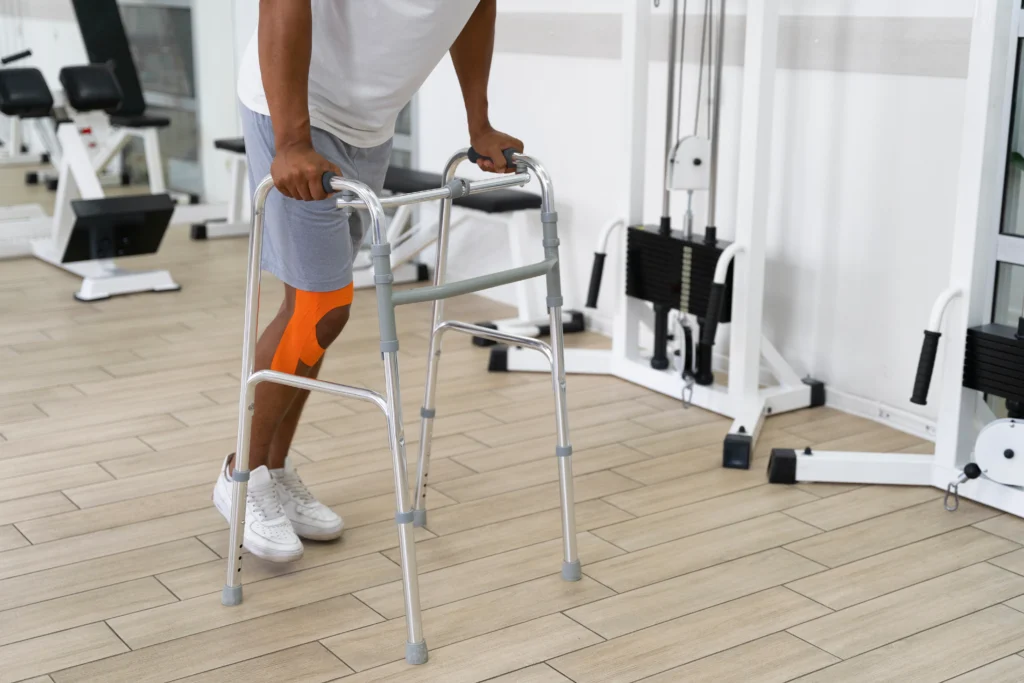Rehabilitation Prosthesis
Introduction
Rehabilitation Prosthesis
The aim of the rehabilitation is to aid the amputee to gain independence at the highest level they can, with the most efficient gait possible. The assessment must take into account the physical capabilities, level of amputation, psychological status, pre-amputation function, existing medical conditions and the patient’s expectations. Rehabilitation should begin 5 days post surgery. A crucial element of constructing a rehabilitation programme is sound gait analysis. This will largely be observational. Validated outcome measures are available to aid goal setting and measure function. Gait analysis consists of observation of the gait, which should occur from all angles. Knowledge of normal gait patterns for the prosthetic and non prosthetic user is required to help analysis of movement. On observation of the gait the assessor compares the function of the amputee to expected patterns of gait and look for deviations. Analysis of the gait pattern will help determine why these deviations are occurring. This will then help to formulate the rehabilitation programme, which includes correction of the deviations. Outcomes measures can be used to monitor progress.

Treatment
Our Rehabilitation Approach
Evaluation
Your rehabilitation physician will start with a comprehensive evaluation. It includes assessing your everyday function, wounds, pain management needs, mental health and other factors. Based on this evaluation, we will develop a tailored treatment plan and coordinate care with other specialists.
Education
You will probably have several questions about your new device and the logistics of living with it. We take the time to talk to you about what to expect in terms of pain management, recovery and function. Our rehabilitation psychologists are also available to help you prepare mentally and emotionally for changes in your lifestyle.
Prosthesis or Orthosis Prescription
Our device specialists help you select or custom order a prosthetic or orthotic device with the right fit. We frequently work with patients who require specialized or high-tech devices for a specific activity, such as running. Beyond the initial fitting, we can also help you with future repairs, replacement and upgrades.
Amputees should perform pre-prosthetic exercises to help maintain ROM and improve muscle strength in the lower limb and residual limb in preparation for using the prosthetic limb. Abdominal and back exercises should also be considered to help trunk control and reduce back pain. Pre-prosthetic limb exercises can help prevent the occurrence of prosthetic gait deviations
Due to the loss of the limb the amputee will automatically shift their centre of gravity over the foot of the non-prosthetic side. After an amputation there will be a period of time where the amputee is without a prosthesis. This is due to the timeframe of the assessments required to decide if the provision of a limb is appropriate. During this period the amputee will become familiar with the shifted centre which will increase the difficulty of reorientation of the centre of gravity once they receive a prosthetic limb
ehabilitation and Prosthetic Services is responsible for the national policies and programs for medical rehabilitation, prosthetic and sensory aids services that promote the health, independence and quality of life for Veterans with disabilities. This office aligns clinical expertise, clinical and practice guidance, and specialized procurement resources to provide comprehensive rehabilitation, prosthetic and orthotic, services across the VHA health care system in the most, economical and timely manner.
Rehabilitation and Prosthetic Services is committed to providing the highest quality, comprehensive, interdisciplinary care; the most advanced medical devices and products that are commercially available; and, promoting advancements in rehabilitative care and evidence-based treatment.

